So much for their resistance to Vatican II…
“Abp.” Carlo Viganò and Taylor Marshall participate in Ecumenical Prayer Rally with Protestants and Jews
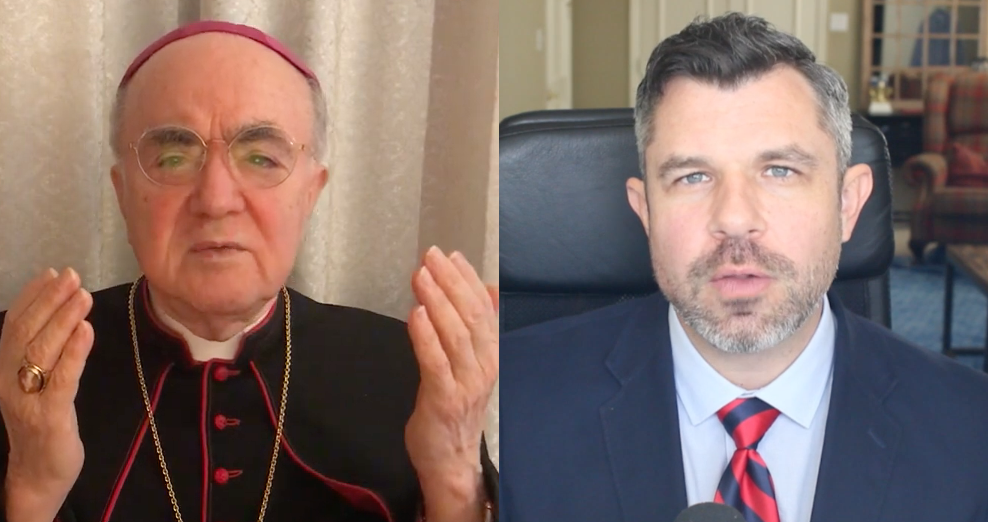
This post is about theology, not politics.
The former nuncio of the Holy See to the United States, “Archbishop” Carlo Maria Viganò, who has been in hiding since accusing “Pope” Francis of knowing about Theodore McCarrick’s sexual crimes, is currently the darling of the semi-traditionalists who, although they acknowledge him as Pope, loathe Francis and the reign of (t)error that has been his hallmark since he usurped the Chair of St. Peter on Mar. 13, 2013.
The reason Viganò is so popular with those who consider themselves traditional Catholics and yet believe the Vatican II Sect to be the Catholic Church, is because he speaks out forcefully against Francis and has publicly condemned many of the theological errors propagated by the New Church, even pointing to the Second Vatican Council (1962-65) as being at the root of it all.
The same can be said, though to a lesser extent, of Dr. Taylor Marshall, a larger-than-life “Catholic” author and commentator who wormed his way into the semi-trad landscape in 2018 by suddenly adopting many of the positions popular among semi-trads and by publishing the hack job Infiltration, shrewdly marketed as a great literary accomplishment (we took it apart in our podcast here and here).
We will return to Marshall later and first turn our attention to Viganò. Let us recall his explosive indictment of Vatican II released in June of this year:
Although that particular missive of his was theologically astute and we acknowledged as much, at the same time Viganò was peddling serious theological errors in a letter he had sent to U.S. President Donald Trump only a day or two prior:
Ironically, Vigano’s theological howlers in this celebrated letter were reminiscent of the Vatican II errors he was denouncing in his other monograph.
It turns out that that was not a one-time gaffe, though, because now the retired nuncio has inserted himself into the public arena again and has done so in a way that should unsettle anyone who considers himself to be a traditional Roman Catholic: This past Saturday, Dec. 12, he participated virtually as a speaker in an interreligious prayer rally that was part of the so-called Jericho March in Washington, D.C. He delivered a pre-recorded video message that ended with a prayer.
Before we examine his words, let’s have a quick look at the nature and goal of the Jericho March. According to the official web site of the organizers:
Jericho March™ is comprised of Judeo-Christians [sic] collectively praying to God to intercede, expose a particular darkness, and bring about justice. As a community of believers, we take our petitions to heaven, and we know that our mighty and powerful God answers and can move mountains.
Jericho was a city of false gods and corruption. Just as Joshua was instructed to march around the walls of Jericho, Jericho Marchers march around at a specific place and time until that darkness is exposed and the walls of corruption fall down.
The Jericho Marches are also a unified celebration of authentic and diverse Judeo-Christian forms [of] worship including praying, chanting, preaching, singing, rosary recitations, Eucharistic processions, and blowing shofars. Individuals and groups on Jericho Marches are self-led.
(“Mission” at JerichoMarch.org; underlining added.)
Obviously, then, the Jericho March is a religious event, indeed an interreligious one, whose primary purpose is collective prayer and worship. The religions chiefly being addressed are Catholicism, Protestantism, and Judaism, and their adherents are all lumped together as a “community of believers.”
The goal of the March on Dec. 12 was announced as follows:
This Election Jericho March™ will culminate in a massive national peaceful prayer rally protest in Washington, D.C. on Dec. 12, 2020 called “Let the Church ROAR!” where we will march around the U.S. Capitol seven times to send a very clear message to national and state leaders as they hear patriots and people of faith roar in support of election integrity, transparency, and reform.
(“Dec 12, 2020 Events” at JerichoMarch.org; underlining added.)
The same blurb added: “We will be hearing from national faith leaders, worship leaders, and others.”
Some of those “faith leaders” Viganò shared the stage with included (names, titles, and descriptions taken from Jericho March web site):
- Bishop Strickland, Catholic Diocese of Tyler, Texas (video)
- Dr. Steve Newman, Jewish patriot
- Dr. Taylor Marshall, Catholic Author and Commentator (video)
- Fr. Frank Pavone, Priests for Life (video)
- Fr. Greg Bramlage, Missionaries of the New Evangelization
- Fr. Hans Jacobse, American Orthodox Institute
- Gail Sheppard and George Michalopulos, Orthodox Christian Religious Commentators
- Kelly Kullberg, Veritas Forum and American Association of Evangelicals
- Rabbi Curt Landry, Curt Landry Ministries
- Rev. Kevin Jessip, The Return, Global Strategic Alliance
The whole event was markedly Zionist. The prayer rally ended with the blowing of the Jewish shofar, a trumpet that calls to repentance and/or to battle. It is a custom that is popular not only among Jews but also among “Christian” Zionists. One of the shofars used had an Israeli flag wrapped around it, in addition to the American flag.
Regardless of the intentions of the organizers, and regardless of whatever merits there may be to the aim for which the March was held, there can only be one response for a real Roman Catholic to such a syncretistic interreligious prayer event: You must stay away under pain of mortal sin and (at least) suspicion of heresy.
The very concept of an ecumenical/interreligious church, roaring or not, must be vehemently rejected by a Catholic. In 1868, Pope Pius IX reminded the world that Protestant sects are not part of the Church founded by Christ and are lacking in unity of faith and government. He noted “that such a state of things is directly opposed to the nature of the Church instituted by our Lord Jesus Christ…” (Apostolic Letter Iam Vos Omnes). In 1928, Pope Pius XI again rejected the idea “that the Church in itself, or of its nature, is divided into sections; that is to say, that it is made up of several churches or distinct communities, which still remain separate, and although having certain articles of doctrine in common, nevertheless disagree concerning the remainder…” (Encyclical Mortalium Animos, n. 7). Vigano knows this.
Also, a Catholic must reject the terminology employed by the Jericho March regarding “people of faith”:
The use by Catholics of such expression as “interfaith meetings” and “persons of different faiths,” whereby non-Catholics are said or implied to have a different faith from Catholics is very unfortunate. The word faith, as traditionally used in the Catholic Church, signifies exclusively the one true faith, which is found only in the Catholic Church. Objectively, the faith is the body of truths that are proposed by the infallible magisterium of the Church as divinely revealed; subjectively, faith is the infused virtue whereby one accepts the truths of divine revelation on account of God’s authority. It is true, the virtue of faith can reside in persons of good will separated from Catholic unity; yet, even in such the infused virtue impels them to believe only what is actually true; it does not extend to doctrines which they themselves may sincerely believe but which are actually false (St. Thomas, Sum. theol., II-II, q. 1, a. 3). The words of St. Paul are very explicit in this connection: “One Lord, one faith, one baptism” (Ephes. 4:5). When Catholics wish to speak of those outside the true fold, they could refer to them as persons of different denominations, different beliefs, different creeds — but the word faith should be retained in its traditional Catholic sense.
(Rev. Francis J. Connell, Father Connell Answers Moral Questions [Washington, D.C.: The Catholic University of America Press, 1959], pp. 10-11; italics given.)
Now let us examine the brief speech delivered by “Abp.” Viganò, which was shown on a gigantic screen at the prayer rally:
A full transcript of the remarks has been posted at the conservative Novus Ordo web site Life Site. We will only quote the portions we intend to comment on. Vigano begins thus:
Dear brothers and sisters,
I greet all of you on this day dedicated to prayer for our beloved Nation, the United States of America. Let’s ask God to make truth and justice triumph! Let’s ask Him to dispel the lies and deceptions of the children of darkness!
First, we observe that the people he addresses as “brothers and sisters” are a motley crew of Novus Ordos, Protestants, Eastern Orthodox, Judaizers, and Jews. Second, it is puzzling that he speaks of the United States as “our beloved Nation”, considering that he is a citizen of Italy, and it has been well over four years that he retired from his role as nuncio to the U.S. Likewise, he subsequently speaks of “our Country and … our President”.
Viganò again makes a reference to the “children of darkness.” We say “again” because he had already introduced the concept in his open letter to President Trump published in June. However, Vigano’s use and understanding of the term and its counterpart — “children of light” — is not orthodox because he uses them in an entirely Naturalist sense and divorces them from the supernatural concept of sanctifying grace (or lack thereof). Our criticism of Vigano’s letter explains this in some detail.
Further on, Vigano makes clear that he identifies with all of the others participating in the prayer rally, saying: “We are the silent army of the children of Light, the humble ranks who overthrow evil by invoking God, the praying army that walks around the walls of lies and betrayal in order to bring them down.” By speaking in the first person plural — “we” — he is making clear that he considers himself one of them and one with them. This is only consistent with the nature and purpose of the event, which the organizers had announced would be “comprised of Judeo-Christians collectively praying to God”.
So Vigano endorses the idea that the “Catholics”, Orthodox, Protestants, and Jews gathered there to demand election transparency and an end to corruption comprise the “children of light”, similar to how the Chosen People of the Old Covenant together brought down the walls of Jericho by faithfully following God’s orders. Does he not see a theological problem with that?
St. Paul once warned the Ephesians: “Let no man deceive you with vain words. For because of these things [sins he had just enumerated] cometh the anger of God upon the children of unbelief. Be ye not therefore partakers with them. For you were heretofore darkness, but now light in the Lord. Walk then as children of the light” (Eph 5:6-8). Who are “the children of unbelief” if not non-Catholics — who are contrasted precisely with the “children of the light”?
Vigano, on the other hand, considers the people he is addressing, collectively, to be the people of God, the “roaring church”: “We fight the battles of the Lord with faith and courage, carrying the Ark of the Covenant in our hearts, remaining faithful to the teachings of the Gospel of Our Lord!” Addressing God in prayer, he even refers to everyone gathered as “this army of Thy children”!
So Vigano believes in a church that is comprised not only of Catholics but also of unbelievers of various stripes, who, presumably because they are fighting for a cause Vigano deems worthy, have been promoted by him to the status of “children of light”, “children of God”, and soldiers in God’s army. And this from a man who is widely seen as staunch and unyielding Catholic traditionalist — it defies belief!
All in all, Vigano’s remarks are dangerous, outrageous, absurd, gravely erroneous theologically, and at least implicitly heretical.
What makes matters worse is that Vigano is not simply your average, run-of-the-mill Novus Ordo bishop who simply doesn’t know better. Quite the contrary — he has demonstrated that he has an astute grasp of real Catholic doctrine and the corresponding errors of Vatican II. We recall that in his spectacular condemnation of the Conciliar religion, dated June 9, 2020, the former nuncio lamented:
Together with numerous Council Fathers, we thought of ecumenism as a process, an invitation that calls dissidents to the one Church of Christ, idolaters and pagans to the one True God, and the Jewish people to the promised Messiah. But from the moment it was theorized in the conciliar commissions, ecumenism was configured in a way that was in direct opposition to the doctrine previously expressed by the Magisterium.
We have thought that certain excesses were only an exaggeration of those who allowed themselves to be swept up in enthusiasm for novelty; we sincerely believed that seeing John Paul II surrounded by charmers-healers, buddhist monks, imams, rabbis, protestant pastors and other heretics gave proof of the Church’s ability to summon people together in order to ask God for peace, while the authoritative example of this action initiated a deviant succession of pantheons that were more or less official, even to the point of seeing Bishops carrying the unclean idol of the pachamama on their shoulders, sacrilegiously concealed under the pretext of being a representation of sacred motherhood.
But if the image of an infernal divinity was able to enter into Saint Peter’s, this is part of a cresecendo which the other side foresaw from the beginning. Numerous practicing Catholics, and perhaps also a majority of Catholic clergy, are today convinced that the Catholic Faith is no longer necessary for eternal salvation; they believe that the One and Triune God revealed to our fathers is the same as the god of Mohammed. Already twenty years ago we heard this repeated from pulpits and episcopal cathedrae, but recently we hear it being affirmed with emphasis even from the highest Throne.
We know well that, invoking the saying in Scripture Littera enim occidit, spiritus autem vivificat [The letter brings death, but the spirit gives life (2 Cor 3:6)], the progressives and modernists astutely knew how to hide equivocal expressions in the conciliar texts, which at the time appeared harmless to most but that today are revealed in their subversive value. It is the method employed in the use of the phrase subsistit in: saying a half-truth not so much as not to offend the interlocutor (assuming that is licit to silence the truth of God out of respect for His creature), but with the intention of being able to use the half-error that would be instantly dispelled if the entire truth were proclaimed. Thus “Ecclesia Christi subsistit in Ecclesia Catholica” does not specify the identity of the two, but the subsistence of one in the other and, for consistency, also in other churches: here is the opening to interconfessional celebrations, ecumenical prayers, and the inevitable end of any need for the Church in the order of salvation, in her unicity, and in her missionary nature.
(“Abp.” Carlo Maria Viganò, Letter of June 9, 2020; printed in full at Life Site; italics given; underlining added.)
Similarly, in a Sep. 1, 2020 letter to Catholic Family News contributor Stephen Kokx, Vigano asserted firmly that “it is clear that no admixture is possible with those who propose adulterated doctrines of the conciliar ideological manifesto….”
So, the question now has to be asked: What happened to all that?! Now he is mixing not only with regular Vatican II believers but also with Protestants, Eastern Orthodox, and Jews, labeling them children of God, children of light, part of the church, and soldiers in God’s army!
Here are some snapshots from the rest of the rally, which lasted over 4 hours:
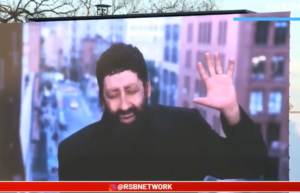
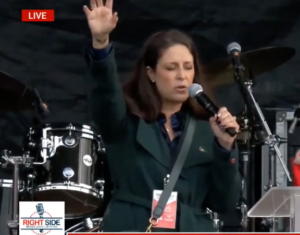
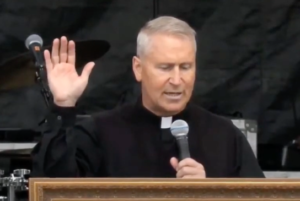
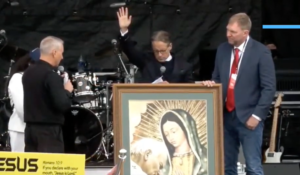
Vigano has quite simply condemned himself. He has participated in a thoroughly ecumenical religious event, one in which not only Protestants (who typically affirm the Holy Trinity) but even Trinity-denying Jews took part. A Dec. 5 press release for Jericho March stated: “The prayer rally will feature national faith leaders including popular evangelical pastors, Catholic clergy, Jewish, and Orthodox leaders; political leaders and elected officials; viral social media influencers and top activists from the political sphere; and praise and worship musicians.” It doesn’t get much more ecumenical than that! And since this was part of the advertisement for the event, it’s not like Vigano didn’t know what he was getting himself into.
The same goes for Taylor Marshall.
Presumably due to his influence and popularity among “conservative Catholics” and traditionalists, Marshall was appointed to the “Catholics for Trump” advisory board in July of this year. Like Vigano, he too delivered a few remarks at the prayer rally and led the interreligious crowd in praying the Our Father, via video:
The complete video feed of the entire prayer rally is embedded below. Fr. Vigano’s appearance begins at the 58:42 timestamp. Marshall’s turn comes at 2:47:45:
Clearly, this was not simply a political event. Above all, it was a religious prayer event, and as such it had been advertised.
The blowing of the Jewish shofar came at the very end:
Apparently Vigano and Marshall thought they’d fit right in with all this. Never mind what the Church’s law decrees on the matter, namely:
Canon 2316
Whoever in any manner willingly and knowingly helps in the promulgation of heresy, or who communicates in things divine with heretics against the prescriptions of Canon 1258, is suspected of heresy.
Canon 1258
§1. It is not licit for the faithful by any manner to assist actively or to have a part in the sacred [rites] of non-Catholics.
§2. Passive or merely material presence can be tolerated for the sake of honor or civil office, for grave reason approved by the Bishop in case of doubt, at the funerals, weddings, and similar solemnities of non-Catholics, provided danger of perversion and scandal is absent.
(1917 Code of Canon Law; Ed Peters translation.)
By taking part in an essentially religious assembly in which “Catholics” prayed together with Protestant heretics and Jews, Vigano and Marshall have made themselves suspect of heresy on that count alone. The heresy in question is Indifferentism, “that false opinion which considers all religions to be more or less good and praiseworthy, since they all in different ways manifest and signify that sense which is inborn in us all, and by which we are led to God and to the obedient acknowledgment of His rule” (Pius XI, Mortalium Animos, n. 2).
So, where is the outrage from the recognize-and-resist crowd? If such an ecumenical prayer rally had been held by liberals such as Blaise Cupich or Robert McElroy for some favorite Novus Ordo cause, would The Remnant and similar publications and blogs not be rending their cyber-garments at this point?
And yet, we find the opposite reaction. Like Life Site, the semi-trad newspaper Catholic Family News has happily published Viganò’s address and prayer on its own web site, with editor-in-chief Brian McCall endorsing the Jericho March in general and Viganò in particular, calling him “a true shepherd given to our nation.” Why McCall would refer to him in this manner is puzzling, considering that Vigano, who has been retired since 2016, has no official role in the entire Vatican II Church, much less in its United States branch specifically.
Of course we know the reason why McCall calls Vigano a “true shepherd”. It is not because the “archbishop” was appointed by the “Pope” to shepherd him and his semi-trad friends but because he happens to agree with what he has to say — “His words were powerful and inspiring”, McCall writes in his introduction –, and so he has personally chosen to accept him as his shepherd. But that is not how teaching and governing authority works in the Roman Catholic Church. The only jurisdiction Vigano exercises is over the titular see of Ulpiana, to which he was appointed on Apr. 3, 1992, by “Pope” John Paul II. Titular sees are extinct dioceses.
Either way, Vigano and Marshall have a lot of explaining to do. In his 2019 book Infiltration, Marshall criticizes Vatican II’s Rahnerian theology of the church, which holds that “[b]eyond the Catholic Church is the wider ‘People of God’, who include not just Catholics but all people of goodwill who profess other religions. This theology opens the way … to the religious ecumenism of Vatican II” (p. 138). Apparently this does not bother Marshall when it comes to a socio-political cause he agrees with.
Some will say that the ecumenical prayer assembly of the Jericho March was very much like the infamous Assisi interreligious prayer for peace event conducted by “Pope” John Paul II in 1986 and 2002. But there is a difference: In Assisi, each of the different religious groups prayed separately, apart from one another; in the ecumenical “Let the Church Roar” rally, the interreligious prayer was collective and offered as a “community of believers.”
So much for the “traditional Catholicism” of Carlo Maria Viganò and Taylor Marshall.
Talk about infiltration!
Image source: youtube.com (screenshots)
License: fair use





No Comments
Be the first to start a conversation